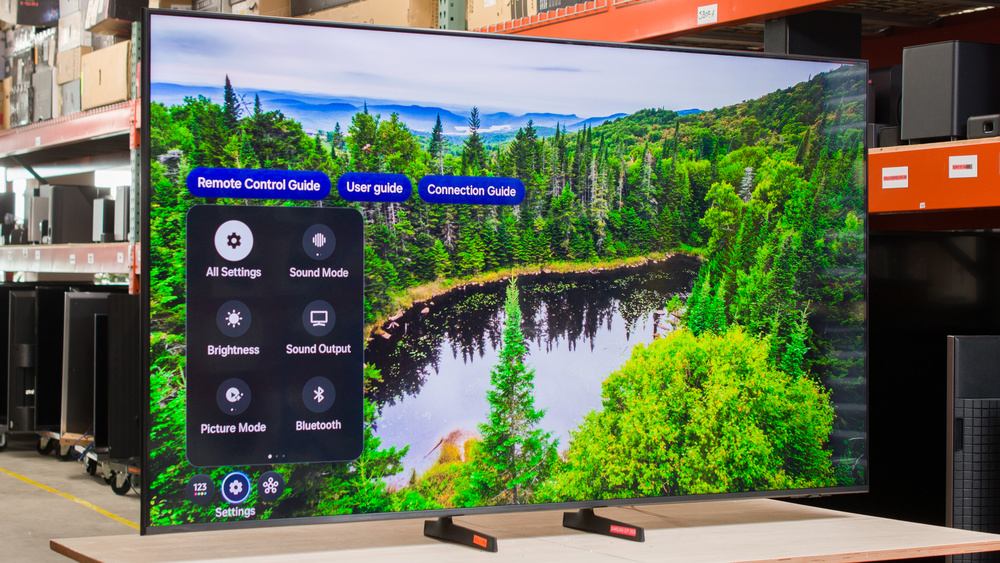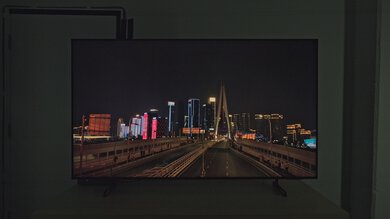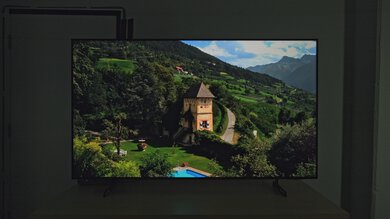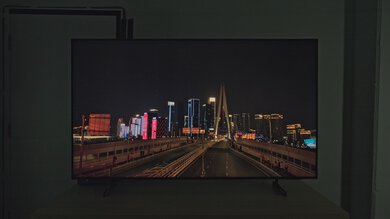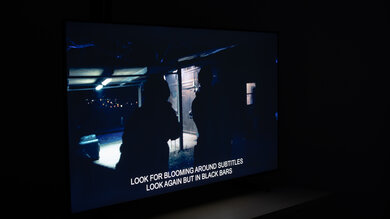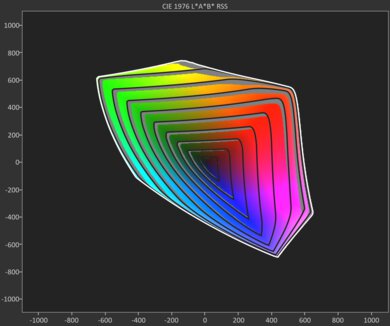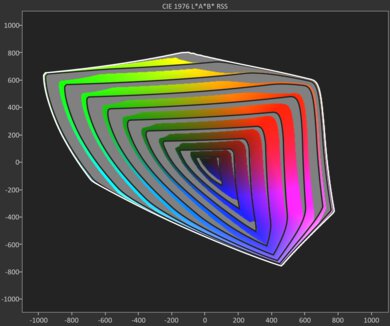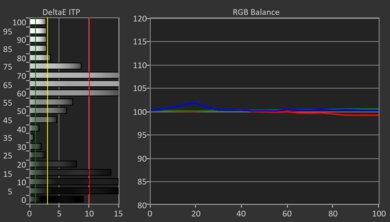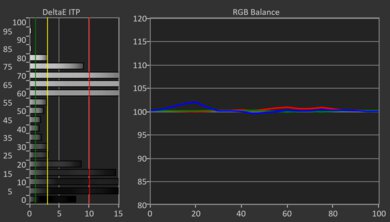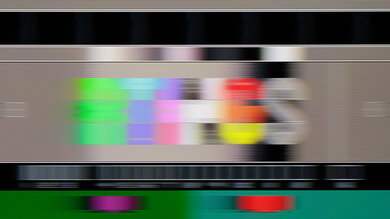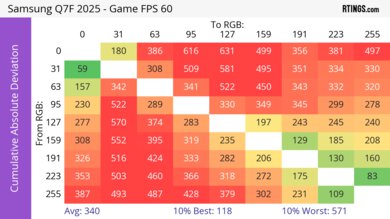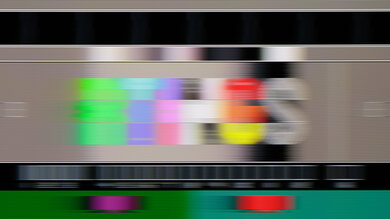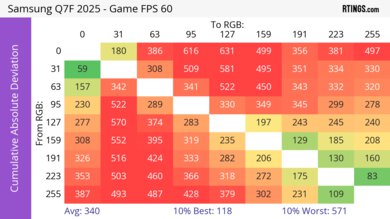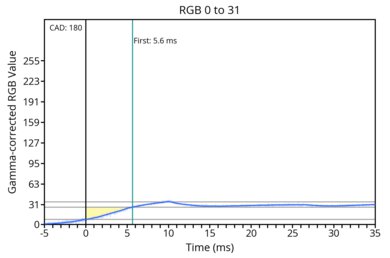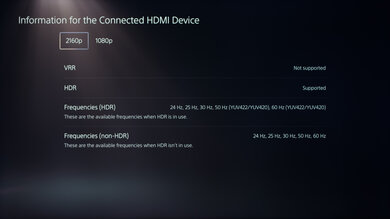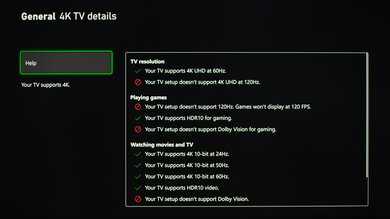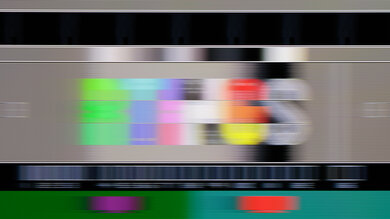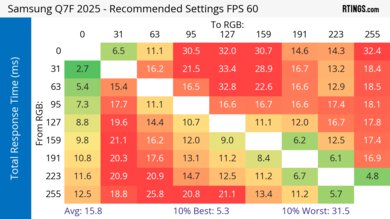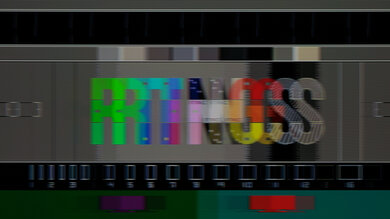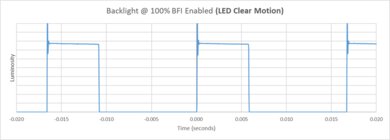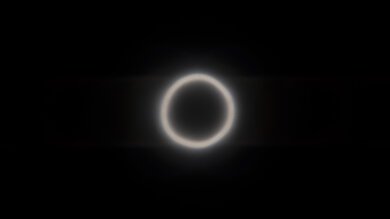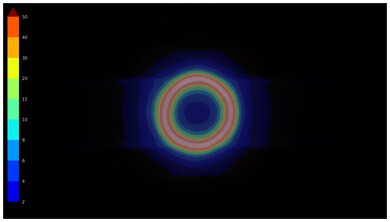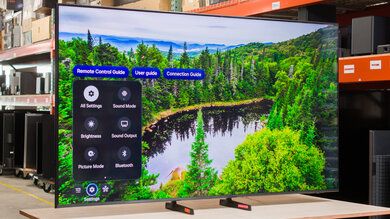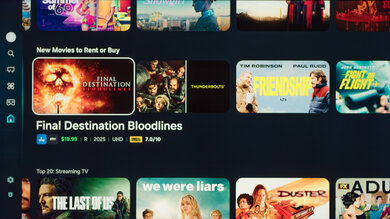The Samsung Q7F is an entry-level model in Samsung's 2025 QLED lineup and sits between the Samsung Q6F and the Samsung Q8F. It's a very basic 4k TV with a 60Hz refresh rate and a slim set of features. It doesn't have local dimming, VRR, HDMI 2.1, Dolby Vision, or DTS audio passthrough. However, the TV supports HDR10+, passes through most Dolby audio formats, and has built-in 20W 2.0 channel speakers. It runs a stripped-down version of Samsung's proprietary Tizen OS, but it's still loaded with streaming apps, has Samsung's TV Plus and Multi-View, supports Apple AirPlay, and offers voice control. We bought and tested the 65-inch model, but it's also available in 43, 50, 55, 75, 85, and 98-inch models.
Our Verdict
The Samsung Q7F is sub-par for mixed usage. Blacks lack depth, colors are muted, and it's very dim in HDR, so it has inadequate image quality in a dark room. Visibility is an issue in a well-lit room since the TV is dim in SDR and has sub-par reflection handling, but it's fine for a room with a couple of overhead lights on. Unfortunately, this isn't a good TV for gamers, as it lacks modern gaming features and has blurry motion. Its viewing angle is just good enough if you're watching the screen from a slight angle, but it's not wide enough for large rooms with seating that's off to the sides of the screen.
Black levels and colors are barely affected by ambient lighting.
Not bright enough in SDR to overcome glare in well-lit rooms.
Too dim in HDR for highlights to stand out.
Sub-par contrast and no local dimming means blacks look grayish.
Doesn't support modern gaming features like HDMI 2.1, 120Hz, and VRR.
Sub-par reflection handling means visibility is an issue in a bright room.
The Samsung Q7F is inadequate for a home theater. Blacks lack depth and look gray most of the time due to its sub-par contrast, colors are dim and muted due to its disappointing color volume, and highlights don't stand out at all in HDR content due to its bad HDR brightness. One of the only positives of this TV for movie fans is its slow response time, which means movies and shows barely have any noticeable stutter, but that doesn't make up for the TV's lackluster image quality.
Great stutter performance.
Excellent SDR color accuracy out of the box.
Too dim in HDR for highlights to stand out.
Sub-par contrast and no local dimming means blacks look grayish.
Dark colors in HDR lack depth and bright colors are dim.
Poor low-quality content smoothing leads to distracting artifacts in low bitrate content.
The Samsung Q7F is inadequate for a bright room. It's a dim model in SDR with sub-par handling of both direct and indirect reflections, so visibility is a real issue in a well-lit room. Black levels and color vibrancy are barely affected by the lighting in your room, but since these are underwhelming to begin with, the image looks washed out and muted. The TV is better suited for a moderately lit room, but even then, you won't be impressed by its picture quality.
Black levels and colors are barely affected by ambient lighting.
Not bright enough in SDR to overcome glare in well-lit rooms.
Colors in SDR are a bit muted and dull.
Sub-par reflection handling means visibility is an issue in a bright room.
The Samsung Q7F is disappointing for watching sports. It has sub-par handling of indirect and direct reflections, and it lacks the brightness needed to counteract glare, so you see reflections on your screen in a well-lit room. Colors are just passable, but they're a bit dim and muted, so the overall image lacks vibrancy. It also has disappointing uniformity, with visible dirty screen effect and uneven brightness that's most noticeable in sports with large playing fields. The TV's viewing angle is okay if you're watching the screen from a slight angle, but it's not good enough for wide seating arrangements.
Excellent SDR color accuracy out of the box.
Colors in SDR are a bit muted and dull.
Sub-par reflection handling means visibility is an issue in a bright room.
Poor low-quality content smoothing leads to distracting artifacts in low bitrate content.
Noticeable dirty screen effect and uneven brightness due to its disappointing gray uniformity.
The Samsung Q7F is a poor gaming TV. It's limited to HDMI 2.0 bandwidth on three ports, only supports 4k @ 60Hz, and lacks VRR, so it doesn't have the features needed to take advantage of your modern console. It has low enough input lag for a responsive feel, but its slow pixel transitions lead to very blurry motion. You also won't be impressed by its lackluster image quality, since colors are muted and blacks look gray. Additionally, the TV is just too dim in HDR for an impactful HDR gaming experience.
Low input lag at 60Hz.
Too dim in HDR for highlights to stand out.
Sub-par contrast and no local dimming means blacks look grayish.
Dark colors in HDR lack depth and bright colors are dim.
Very slow pixel transitions in Game Mode leads to blurry motion.
Doesn't support modern gaming features like HDMI 2.1, 120Hz, and VRR.
The Samsung Q7F has bad brightness overall. The TV's SDR brightness is sub-par, so it's not bright enough to overcome glare in a well-lit room. Furthermore, highlights in HDR content are dim and don't stand out at all; this isn't the TV to buy if you want an impactful HDR experience.
Not bright enough in SDR to overcome glare in well-lit rooms.
Too dim in HDR for highlights to stand out.
The Samsung Q7F has poor black levels. The TV does have excellent black uniformity, but that doesn't save the image from its sub-par contrast, so blacks look grayish, and the image looks a bit washed out.
Excellent black uniformity.
Sub-par contrast and no local dimming means blacks look grayish.
The Samsung Q7F has unremarkable colors. The TV's SDR color accuracy is excellent, which is great if you want colors to look the way they should. However, the TV's SDR color volume is only passable, so colors are muted and look a bit lifeless. Its HDR color volume is disappointing, leading to colors in HDR content that look washed out and dim. HDR color accuracy is okay out of the box, but since calibrating the TV doesn't do much to improve it, this isn't a TV for people who care about accurate colors in HDR.
Excellent SDR color accuracy out of the box.
Colors in SDR are a bit muted and dull.
Dark colors in HDR lack depth and bright colors are dim.
Note: We're in the process of improving our tests related to image processing, but this score should give you a general idea of how a TV performs overall with its image processing capabilities.
The Samsung Q7F has unremarkable image processing. Its upscaling is adequate, so you don't have to look at an overly soft image when watching low-resolution content, but it still lacks some details. Unfortunately, the TV's low-quality content smoothing is poor, so low-bitrate content has visible artifacts. The TV's gradient handling is decent, so even though there's some banding in most color gradients, it's not too distracting. The TV does a good job overall of displaying HDR content at the brightness level intended by the filmmaker, but it's not perfect, and blacks are raised while highlights are too dim.
Good HDR brightness accuracy.
Poor low-quality content smoothing leads to distracting artifacts in low bitrate content.
The TV has poor responsiveness in its dedicated gaming mode. It has low enough input lag for a responsive feel, but since it's limited to 4k @ 60Hz, you don't get the benefit of the low input lag provided by higher refresh rates. The TV doesn't support VRR, so you do see some screen tearing in games that can't keep a consistent frame rate. Finally, fast motion is very blurry on this TV due to its slow pixel transitions.
Low input lag at 60Hz.
Very slow pixel transitions in Game Mode leads to blurry motion.
Doesn't support modern gaming features like HDMI 2.1, 120Hz, and VRR.
We're in the process of fixing the way we evaluate a TV's overall motion handling. This section is currently broken, and the score isn't indicative of how well a TV handles motion overall.
Performance Usages
Changelog
-
Updated Nov 12, 2025:
We bought and tested the TCL QM5K and added a comparison in the SDR Brightness section.
-
Updated Oct 31, 2025:
We bought and tested the Samsung Q8F 2025, and added a comparison in the Input Lag section.
-
Updated Oct 09, 2025:
Added the new 98-inch model to the Differences Between Sizes and Variants section.
-
Updated Sep 16, 2025:
We bought and tested the Samsung U8000F, and added a comparison in the SDR Color Volume section.
Check Price
Differences Between Sizes And Variants
We've bought and tested the 65-inch Samsung Q7F 2025, which is also available in 43, 50, 55, 75, 85, and 98-inch sizes. All sizes offer the same picture quality and overall performance. Note that with Samsung TVs, the four letters after the short model code (FXZA in this case) vary between different retailers and regions, but there's no difference in performance.
Costco and Sam's Club sell a variant of this TV known as the Samsung Q7FD. This variant performs the same but comes with an extended warranty. Some retailers, like Walmart, sell the TV as the Samsung Q7FB, and it also performs the same.
| Size | US Model | Costco & Sam's Club Model (US) |
| 43" | QN43Q7FAAFXZA | - |
| 50" | QN50Q7FAAFXZA | - |
| 55" | QN55Q7FAAFXZA | QN55Q7FDAFXZA |
| 65" | QN65Q7FAAFXZA | QN65Q7FDAFXZA |
| 75" | QN75Q7FAAFXZA | QN75Q7FDAFXZA |
| 85" | QN85Q7FAAFXZA | QN85Q7FDAFXZA |
| 98" | QN98Q7FAAFXZA | - |
Our unit was manufactured in February 2025, as seen on the photo of our unit's label.
Popular TV Comparisons
The Samsung Q7F is a sub-par TV overall, and it doesn't offer good value. It's inadequate for home theaters due to its poor black levels, muted colors, and bad HDR brightness. Since the TV is dim in SDR and has sub-par reflection handling, it's also not suitable for well-lit rooms. If you're a gamer with a modern console, this TV won't take advantage of your console's capabilities, since it's limited to 4k @ 60Hz and doesn't support VRR. It's really not a good choice for anyone, especially considering the price it's sold for. If you're thinking about buying this TV, you can get the similarly priced Hisense U65QF or TCL QM6K instead. Both of those models have substantially better image quality and a full suite of gaming features, so they're much better options for anyone.
For more options, check out our recommendations for the best TVs under $1,000, the best 65-inch TVs, and the best TVs for gaming.
The Samsung Q8F 2025 is a noticeable step up from the Samsung Q7F 2025. The Q8F is much more feature-packed, with VRR support, a high refresh rate, and HDMI 2.1 bandwidth on all four inputs. Outside of these extra features, though, there's not much difference, and they deliver similar overall picture quality.
The Samsung Q7F 2025 is very slightly better than the Samsung U8000F. The Q7F gets a tiny bit brighter, it has better contrast, and it has slightly better contrast, but these three differences are very minor overall. Even though the U8000F is a lower-end model, it does have one minor advantage over the Q7F in that it supports VRR. Since it's limited to a 60Hz refresh rate, though, this feature isn't very useful for most people.
The TCL QM6K is much better than the Samsung Q7F 2025. The TCL has local dimming, so it displays much deeper blacks. Peak brightness is also a lot better on the TCL, so it fights more glare in a well-lit room and provides more impactful highlights in HDR. Colors are a lot more vibrant on the TCL, and it has better low-quality content smoothing, so all forms of content look better on it. Finally, the TCL has a full suite of gaming features, making it the much better option for gamers.
The TCL QM5K is significantly better than the Samsung Q7F 2025. It's a lot brighter, allowing it to handle more glare in a bright room and delivering a more impactful HDR experience. The TCL also features a full-array local dimming system, delivering deeper, more uniform blacks and an overall better dark room experience. Finally, the TCL delivers a better gaming experience, with a higher refresh rate at low resolutions and VRR support to reduce tearing.

We buy and test dozens of TVs yearly, taking an objective, data-driven approach to deliver results you can trust. Our testing process is complex, with hundreds of individual tests that take over a week to complete. Most of our tests are done with specially designed test patterns that mimic real content, but we also use the same sources you have at home to ensure our results match the real-world experience. We use two main tools for our testing: a Colorimetry Research CR-100 colorimeter and a CR-250 spectroradiometer.
Test Results

The Samsung Q7F has bad HDR brightness. Its brightness is consistent across all scenes, but since the TV is very dim in HDR, highlights and bright scenes don't stand out the way they should. Combined with the TV's subpar contrast, this model doesn't provide an impactful HDR experience.
Our test is done in the Filmmaker Mode with 'HDR Tone Mapping' set to 'Static'. Below are the results with 'HDR Tone Mapping' set to 'Active', which doesn't do much to increase peak brightness during most scenes.
- Hallway Lights: 285 cd/m²
- Yellow Skyscraper: 230 cd/m²
- Landscape Pool: 173 cd/m²
There's no noticeable difference in brightness when using Game Mode. The above results are with Game HDR set to 'Basic' and HDR Tone Mapping set to 'Static.'
Results with 'HDR Tone Mapping' set to 'Active', which doesn't do much to increase peak brightness during most scenes.
- Hallway Lights: 280 cd/m²
- Yellow Skyscraper: 226 cd/m²
- Landscape Pool: 161 cd/m²
The Samsung Q7F has sub-par SDR brightness. Its brightness is consistent in most scenes, but the TV is too dim to overcome glare in a well-lit room. It's best suited for a dark room or one with just a couple of overhead lights on. If you want something with similar gaming features but much better brightness, check out the TCL QM5K instead.
The Samsung Q7F has subpar contrast. Its native contrast is better than other similar entry-level TVs like the Panasonic W70B, but it lacks local dimming so the overall experience is worse than Mini LED models like the Hisense QD7QF. It lacks a local dimming feature, though, so blacks appear gray and washed out most of the time. If you want the deepest blacks possible without spending a ton, take a look at the Philips 974 Series OLED.
This TV doesn't have a local dimming feature, so it can't adjust the backlight of individual zones to brighten up highlights without impacting the rest of the image. This means that there are no distracting flickers or brightness changes as bright highlights move between dimming zones.
The TV has passable SDR color volume. It covers the entirety of the most commonly used BT.709 SDR color space, so it doesn't have any problems displaying colors in most SDR content. However, it lacks the color volume in DCI-P3 to fully display dark colors, and it struggles even more with lighter ones. Furthermore, it has poor coverage of the widest BT.2020 color space, covering only about half of it. It's slightly better than other similar entry-level TVs like the Samsung U8000F, but you still shouldn't consider this TV if you enjoy saturated colors.
Oddly, like the Samsung QN80F, colors noticeably desaturate as lightness increases. While it's common for TVs to lose 3-5% coverage as the lightness increases, both this TV and the QN80F lost as much as 15% coverage at higher luminance levels. This is unusual for TVs that lack a white subpixel.
| Volume ΔE³ | DCI-P3 Coverage |
BT.2020 Coverage |
|---|---|---|
| L10 | 89.00% | 64.42% |
| L20 | 89.04% | 63.22% |
| L30 | 87.80% | 62.18% |
| L40 | 85.11% | 61.25% |
| L50 | 82.43% | 60.05% |
| L60 | 76.67% | 54.91% |
| L70 | 70.92% | 45.70% |
| L80 | 70.52% | 43.49% |
| L90 | 71.06% | 43.66% |
| L100 | 74.73% | 48.79% |
| Total | 77.21% | 52.25% |
The TV's HDR color volume is disappointing. Without local dimming, it can't display dark saturated colors well, so darker tones lack depth. Its low peak brightness limits its ability to display bright, vibrant colors, and even whites look a bit dim.
The Samsung Q7F has excellent SDR color accuracy before calibration. Darker scenes are too dark, and some brighter scenes are a bit too bright, but the TV's white balance and gamma are still very good overall. Color temperature is very close to the industry standard 6,500K, and overall color accuracy is amazing, so this is a TV that displays a mostly accurate image out of the box.
After calibration, the TV still has excellent SDR color accuracy, but calibrating it doesn't do much. White balance, gamma, and color accuracy have all improved, but improving these aspects makes the TV's color temperature a bit too cool. Since the TV already has excellent accuracy out of the box, calibrating it isn't worth it for the vast majority of people.
See our full calibration settings.
The TV has okay HDR accuracy before calibration. Its white balance is good, but there's too much blue in some grays, and not enough red in others. This partially contributes to the TV's poor color temperature, which is noticeably too cold. Colors have decent accuracy overall, but there's mapping errors throughout.
Unfortunately, calibrating the TV doesn't do much to improve HDR color accuracy. Color temperature and accuracy have barely improved, and any small improvements are barely noticeable. It's not worth paying the price for calibration on this model.
Update 07/30/2025: Samsung has removed HGIG with firmware update 1125.9. Their intention was to move it to the "Original" Game Genre setting, but it's not working properly. This means that most games won't be displayed at the correct brightness level, and it's especially problematic for Switch 2 players, as HGIG is needed to properly calibrate that console's HDR output.
The Samsung Q7F has good PQ EOTF tracking. Blacks and shadows are brighter than intended, but the TV follows the curve closely outside of that. There's a slight roll off with content mastered at 600/1000 nits, and a more gradual roll off with content mastered at 4000 nits, which helps to maintain some detail in highlights that are brighter than the TV's capabilities.
The TV has decent gradient handling in HDR. There's some visible banding in most color gradients, but it's not overly distracting in most real content.
This TV has low input lag at 60Hz when set to Game Mode. Unlike the step-up Samsung Q8F 2025, it doesn't support 120Hz and above at any resolution, so you don't get the benefits of the lower input lag you get when gaming at higher refresh rates.
The Samsung Q7F supports all common resolutions up to 4k @ 60Hz. It displays chroma 4:4:4 properly with any signal as long as the input label is set to PC, which is important for reading clear text from a PC.
This TV doesn't support VRR to reduce screen tearing.
The Samsung Q7F 2025 doesn't support a 120Hz refresh rate.
The Samsung Q7F 2025 is a 60Hz TV, so it only supports 4k @ 60Hz on the P55. It has Auto Low Latency Mode (ALLM), so it'll automatically switch to Game Mode when the TV detects a game console as its input device, which gives you the lowest possible input lag for games. 1440p @ 60Hz doesn't work with the PS5 and this TV.
The Samsung Q7F 2025 is a 60Hz TV, so it only supports 4k @ 60Hz on the Xbox Series X|S. It has Auto Low Latency Mode, so it'll automatically switch to Game Mode when the TV detects a game console as its input device, which gives you the lowest possible input lag for games. You can force 1440p @ 60Hz, but doing so locks you out of ALLM and HDR. However, there's no point in choosing 1440p as a resolution on this TV.
Due to the TV's slow response time, there's very little noticeable stutter when watching 24p content.
The TV gives a judder-free experience with 24p sources like a Blu-ray player and native apps. Unfortunately, it doesn't remove 24p judder from 60Hz sources like most cable TV boxes and older streaming devices that lack a Match Frame Rate feature.
The TV uses pulse-width modulation (PWM) to dim its backlight, which introduces flicker that can bother people who are sensitive to it. The amount of flicker varies depending on what picture mode the TV is set to and what settings you're using. When using 'Filmmaker Mode,' the TV flickers at 120Hz with all brightness levels. It flickers at 480Hz in all other picture modes with the brightness set above '19' and flickers at 120Hz with the brightness set to '19' and below.
The TV supports backlight strobing, more commonly known as black frame insertion (BFI). The feature is designed to improve the appearance of motion by strobing its backlight and reducing the amount of persistence blur. The BFI feature on the TV flickers at 60Hz, and there's noticeable image duplication present.
The TV has optional motion interpolation to help smooth out low-frame-rate content. It does an okay job of smoothing slower-moving scenes, but it struggles so much with faster scenes that there are noticeable artifacts and haloing around characters. Sometimes, the TV stops interpolating altogether, which causes motion to look inconsistent and is distracting.
The TV's direct reflection handling is sub-par. While it does reduce the intensity of direct reflections to a small degree, they're still very obvious, leading to an unpleasant viewing experience when you have bright lights or windows shining directly on the TV.
The TV does a fantastic job retaining its black levels in a bright room. Blacks are barely raised as more light is added to your room, so you get very similar black levels regardless of your lighting. That said, it has poor black levels to begin with, so you never see deep blacks on this model.
The amount of total reflected light is subpar. While the TV's handling of ambient lighting is passable, it does so with some obvious light banding. If you want a TV with similar overall specs but better reflection handling, check out the Hisense QD6QF instead.
The TV has okay color saturation when used in a well-lit room. Overall, there's barely any difference in the vibrancy of colors, whether you're in a dark room or a bright one, although darker colors look slightly more washed out. Still, it has somewhat limited color volume to begin with, so colors lack vibrancy regardless of your lighting conditions.
The TV's viewing angle is just okay. It looks fine from a slight angle, but there's significant gamma shifting, black level raise, brightness loss, and colors look increasingly washed out as you move further away to the sides. Since its image quality is noticeably degraded when viewed from the sides of the screen, it's not a good choice for wide seating arrangements.
The TV has disappointing gray uniformity. The sides of the screen are a lot darker than the middle area, there are some uneven areas of brightness across the entire screen, and there is a visible dirty screen effect towards the middle. It's a bit better on a near-black screen, but there are still uneven areas of brightness.
The TV uses a BGR (Blue-Green-Red) subpixel layout instead of the traditional RGB layout. For video or gaming content, this doesn't cause any issues, but for PC monitor use, it can be a problem as it impacts the text clarity, although not everyone will notice this.
The TV is direct lit and has decent separation between colors, which helps somewhat with its color purity and its ability to display a satisfactory range of colors, although they don't look vibrant.
This TV supports most Dolby Digital audio formats. However, like other 2025 Samsung models, it doesn't passthrough Dolby Digital Plus 7.1. Unfortunately, it also doesn't support DTS formats, which is disappointing, as many Blu-rays use DTS for their lossless audio tracks.
Like all Samsung TVs, the Samsung Q7F 2025 doesn't support Dolby Vision, but it does support the similar HDR10+.
The TV uses a pair of plastic feet that can be adjusted into different positions depending on your needs. The narrow position (pictured above) brings the feet close together, which is great for smaller tables. You can also keep the feet close together and raise the height. If you're more worried about stability, you can widen the feet and set them to either a high or low position. In the higher position, the feet lift the TV about 3.58 inches above the table, so almost any soundbar fits underneath. In the low position, the feet lift the TV about 2.6 inches.
The footprint of the 65-inch stand is 40.16" x 10.6" in the wide position and 11.85" X 10.6" in the narrow position.
The back of the TV is made from plastic. All of the inputs are on the right side of the TV when facing the front, but they're in a recessed cutout that makes them quite hard to access if you have it wall-mounted. The back has grooves and a clip that can be attached to one of the feet to help with cable management.
The Samsung 65Q7F has alright build quality overall. It wobbles a bit in the high and narrow position when you're cleaning the screen, but it settles quickly and doesn't cause any issues. There's quite a bit of flex on the back panel that becomes more pronounced near the VESA mounting points, but it doesn't prevent you from wall-mounting it.
The Samsung Q7F Series comes with the 2025 version of Samsung's proprietary Tizen OS but has a reduced feature set compared to more expensive models, so you don't get features like TV to Mobile or Ambient Mode+. The interface is a bit slow at times, but it's still easy to find content to watch.
The Samsung Q7FD has an okay frequency response. Like most TVs, there's almost no bass, so it's best to pair it with a good soundbar. The sound profile is well-balanced at moderate volume levels, so dialogue is clear. Unfortunately, the sound profile becomes unbalanced at the TV's maximum volume, making dialogue hard to understand during louder scenes. Since the TV doesn't get very loud, it's best suited for a quiet environment.
